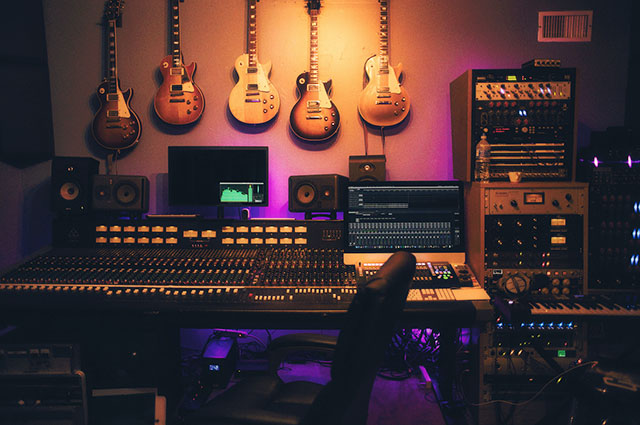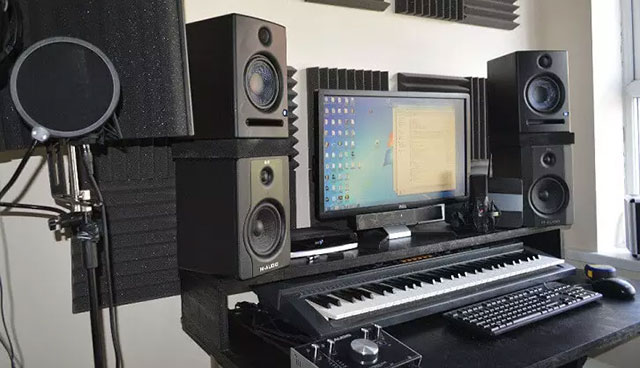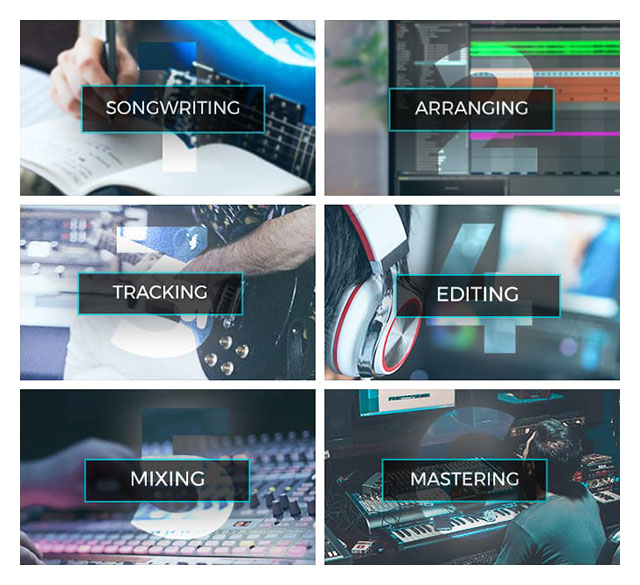 Music production is creating, recording and manipulating sound to produce a final musical product. It involves various tasks, from composing and arranging music to recording and mixing tracks. Essentially, music production is the art of making music that's technically sound and artistically compelling.
Music production is creating, recording and manipulating sound to produce a final musical product. It involves various tasks, from composing and arranging music to recording and mixing tracks. Essentially, music production is the art of making music that's technically sound and artistically compelling.
Music production is an essential aspect of the music industry. Without it, we wouldn't have the vast array of music that we enjoy today. Music production is the backbone of the music industry and is responsible for the quality and sound of the music we hear. It allows musicians and artists to express their creativity and is an art form.
This article will cover everything you need to know about music production. We'll cover everything from understanding the basics of music production to choosing the right equipment and setting up your music production studio. We'll also discuss composition and arrangement techniques, sound design and synthesis, recording techniques, audio engineering, collaboration and networking and promoting and distributing your music. By the end of this article, you'll have a comprehensive understanding of music production and be on your way to producing music like a pro.
Music production creates and records music using various techniques, tools and software. It involves several stages: composing, arranging, recording, editing, mixing and mastering. The goal is to create a final product that's technically sound, artistically compelling and commercially viable.
The different stages of music production include pre-production, production and post-production. Pre-production involves planning and preparing for the production process, such as composing, arranging and rehearsing the music. Production is the actual recording of the music, which consists of capturing the performance and creating multiple takes for each instrument or vocal part. Post-production involves editing, mixing and mastering the recorded tracks to make the final product.
Music production involves various professionals, including musicians, composers, arrangers, producers, engineers, mixers and mastering engineers. Each professional has specific roles and responsibilities in the music production process. For example, the producer oversees the entire production process and ensures that the final product meets the artistic and commercial goals. The engineer is responsible for capturing the performance and creating a quality recording, while the mixer is responsible for combining and balancing the individual tracks to create a cohesive sound.
Understanding music theory is crucial for music production. It provides a foundation for composing, arranging and producing music. Music theory includes concepts such as harmony, melody, rhythm and form, essential for creating musically exciting and technically sound music. Without an understanding of music theory, it isn't easy to make music that's coherent and pleasing to the ear.
Understanding the basics of music production is essential for producing high-quality music. By understanding the different stages of music production, the roles and responsibilities of other professionals and the importance of music theory, you'll be on your way to producing music like a pro.
 Music production involves a wide range of equipment that can be used to create and manipulate sound. At a basic level, music production requires a computer or mobile device, headphones or speakers and software to record and edit audio. However, as you progress in music production, you must invest in more advanced equipment to achieve higher sound quality. Some essential equipment for music production includes:
Music production involves a wide range of equipment that can be used to create and manipulate sound. At a basic level, music production requires a computer or mobile device, headphones or speakers and software to record and edit audio. However, as you progress in music production, you must invest in more advanced equipment to achieve higher sound quality. Some essential equipment for music production includes:
When it comes to music production equipment, there are many different options available. The equipment you choose will depend on your budget, the type of music you want to produce and your preferences. Here are some common types of software and hardware options:
When choosing music production equipment, there are several factors you should consider. These include:
Choosing the right equipment for music production is essential to achieving high-quality sound. By considering your budget, music genre, experience level and future goals, you can make informed decisions about which equipment to purchase.
Creating a dedicated space for music production is important because it allows you to focus solely on the task without distractions. A dedicated space can be as simple as a small corner in your home or as elaborate as a full-fledged recording studio. Choosing a comfortable space that has good acoustics and is free from any outside noise or interference is essential. This will ensure that you can create music in an environment that allows you to focus and be creative.
To create an ideal music production environment, you should consider factors such as lighting, temperature and acoustics. Lighting is essential for creating a comfortable environment that's conducive to creativity. Natural light is ideal, but if that's impossible, invest in good lighting that's easy on the eyes. Temperature is also critical, as it can affect your comfort level and ultimately your ability to focus. Ensure your studio is kept at a comfortable temperature for you to work in.
Acoustics are perhaps the most critical factor in creating an ideal music production environment. The acoustics of your studio will affect the sound quality of your recordings. You should consider using sound-absorbing materials such as acoustic panels and bass traps to create an acoustically optimized space. You should also invest in high-quality headphones and monitors that accurately reproduce sound.
When setting up your music production studio, keeping it organized and tidy is essential. Invest in proper storage solutions for your equipment, cables and other accessories. Use cable ties to keep cables organized and avoid tripping hazards. Consider purchasing a desk with built-in cable management to keep your workspace clean and organized.
It's also essential to keep your studio free from clutter. Avoid storing non-essential items in your studio, as they can quickly pile up and create distractions. Focus on the main task and only keep the equipment and accessories you need to produce music.
Finally, consider the ergonomics of your workspace. Ensure your studio is set up in a comfortable way and conducive to long working hours. Invest in a comfortable chair and consider purchasing a footrest to improve your posture and reduce strain on your back. These small changes can significantly affect your comfort level and ultimately your ability to create high-quality music.
 Creating a structured workflow for music production is essential for several reasons. First, it helps to ensure that the production process is organized and efficient, enabling you to complete projects on time and within budget. A workflow also helps ensure that all aspects of the production process from recording to mixing and mastering are completed to a high standard. This is important because even the slightest mistake can significantly impact the final product's quality.
Creating a structured workflow for music production is essential for several reasons. First, it helps to ensure that the production process is organized and efficient, enabling you to complete projects on time and within budget. A workflow also helps ensure that all aspects of the production process from recording to mixing and mastering are completed to a high standard. This is important because even the slightest mistake can significantly impact the final product's quality.
There are many different approaches to music production workflows, and the best one for you will depend on your preferences and the type of music you produce. Some producers prefer to work linearly, starting with the basics of the song and working through each element in a structured way until the final product is complete. Others prefer to work more freely, allowing creativity to guide them as they experiment with different sounds and ideas.
Another popular approach is the "modular" workflow, where producers work on different aspects of the song in separate modules or sessions. This can help keep the process organized and manageable, allowing for more flexibility and experimentation.
Regardless of the approach you choose, some general tips can help you create an effective music production workflow:
Creating an effective music production workflow takes time and practice. Still, by following these tips and experimenting with different approaches, you can develop a workflow that works best for you and your music.
 Composition and arrangement are essential aspects of music production that can determine the success or failure of a song. Composition refers to creating musical ideas or concepts, while arrangement involves organizing those ideas into a complete musical composition. Effective composition and arrangement techniques can help make memorable and impactful music that resonates with listeners.
Composition and arrangement are essential aspects of music production that can determine the success or failure of a song. Composition refers to creating musical ideas or concepts, while arrangement involves organizing those ideas into a complete musical composition. Effective composition and arrangement techniques can help make memorable and impactful music that resonates with listeners.
One of the most crucial elements of music composition is creating a memorable melody. A good melody should be catchy, memorable and emotionally impactful. To create a memorable melody, you should experiment with different chord progressions and use repetition to emphasize specific melodic motifs. Additionally, harmonies can add depth and complexity to a melody. You should experiment with different harmonies to create exciting and dynamic musical arrangements.
The structure of a song refers to the order of different musical sections, such as verses, choruses and bridges. Several approaches to song structure and arrangement exist, including traditional song structures like verse-chorus-verse and more experimental structures. Effective song arrangement can create a sense of tension and release that keeps listeners engaged throughout the song.
You should experiment with different instrumentation and arrangement techniques to create a dynamic and engaging sound when arranging a song. You can use instrumentation to create contrasting sections and highlight specific song elements. Additionally, you should pay attention to dynamics, tempo and pacing to create a cohesive and impactful musical arrangement.
In summary, composition and arrangement are essential aspects of music production that can help create memorable and impactful music. Effective composition techniques can help create unique melodies and harmonies, while effective arrangement techniques can create a cohesive and dynamic musical arrangement. You can create unique and memorable music that resonates with listeners by experimenting with different styles and approaches.
Sound design and synthesis refer to creating, manipulating and shaping sound elements to create a cohesive musical piece. It involves using different tools, software and hardware to create unique and exciting sounds that complement the composition and arrangement of a track. Sound design and synthesis are essential aspects of music production, as they allow producers to create distinctive and recognizable sounds that set their music apart from others.
Creating unique and compelling sounds involves experimenting with different types of synthesis and sound design techniques. This can include using oscillators, filters and envelopes to create sounds from scratch or using samples and manipulating them to create new sounds. One approach is to start with a basic sound and then manipulate it using various effects and processing techniques. Another method is to layer different sounds together to create a more complex and unique sound.
When creating sounds, it's essential to consider how they will fit into the overall track. This means thinking about the sound's timbre, tonality and rhythm and how it will interact with other sounds in the track. It's also important to consider the emotional impact of the sound and how it will affect the listener.
Producers can use several different types of synthesis to create sounds, including subtractive, additive, wavetable and frequency modulation synthesis.
Subtractive synthesis involves starting with a complex sound and filtering out unwanted frequencies to create a simpler sound. Additive synthesis involves starting with simple waveforms and layering them together to create more complex sounds. Wavetable synthesis uses pre-recorded waveforms to make sounds, while frequency modulation synthesis involves using one waveform to modulate another waveform to develop complex and exciting sounds.
Each type of synthesis has its strengths and weaknesses, and producers often use a combination of synthesis techniques to create a unique sound. Understanding the different types of synthesis and their characteristics can help producers choose the proper method for their music production needs.
Sound design and synthesis are essential aspects of music production that allow producers to create unique and compelling sounds. Experimenting with different synthesis and sound design techniques can help producers develop sounds that complement their tracks and set their music apart.
Recording techniques and audio engineering play a crucial role in the final sound of music production. Recording aims to capture the best possible sound from a musician or instrument and bring it to the production process. Audio engineering, on the other hand, involves manipulating and enhancing the recorded sound to achieve a specific sound aesthetic. Recording techniques and audio engineering are equally important in achieving the desired sound in music production.
To get the best sound from your recording equipment, choose the right equipment for the job. Some critical factors include microphone selection, preamp choice and room acoustics. A good microphone is crucial in capturing quality sound. It's also essential to select a preamp that complements your microphone choice. Additionally, the acoustics of the room can impact the final sound. Therefore, it's vital to choose a space with good acoustics or make necessary adjustments to the room to achieve optimal sound quality.
Mixing and mastering are the final stages of music production. Mixing involves combining and adjusting the various tracks in a production to achieve a balanced and cohesive sound. In contrast, mastering consists of making final adjustments to the track's overall sound, including compression, equalization and limiting. Mastering aims to ensure the final mix sounds good on all playback systems.
When mixing, paying attention to levels, panning and EQ is essential. Levels refer to the relative volume of each track, while panning refers to the placement of the tracks in the stereo field. EQ is used to adjust the frequency balance of each track. Using EQ can help to eliminate frequency clashes between tracks and bring out certain parts of the mix.
When mastering, it's important to use reference tracks to ensure the final mix sounds good on all playback systems. It's also essential to avoid over-compressing and over-limiting the mix, which can cause the sound to lose dynamics and become overly loud. Finally, it's necessary to use a proper format and settings for the final mix to ensure it can be played on various playback systems.
Overall, recording techniques and audio engineering are essential for producing quality sound in music. Paying attention to microphone selection, preamp choice and room acoustics can help to achieve optimal sound quality. When mixing and mastering, it's essential to pay attention to levels, panning and EQ, and to use reference tracks to ensure the final mix sounds good on all playback systems.
Collaboration and networking are crucial aspects of music production. While producing music can be a solitary process, working with other producers, artists and musicians can bring fresh ideas and perspectives to your work. Collaboration also offers growth opportunities as you learn from the skills and experiences of others.
On the other hand, networking is essential for establishing connections within the music industry. Meeting and connecting with other producers, engineers, artists and industry professionals can lead to new opportunities and collaborations, which can help advance your career as a music producer.
One way to connect with other music producers and artists is through social media platforms such as Facebook, Twitter and Instagram. These platforms provide opportunities to engage with other producers and artists, share your work and discover new talent.
Another way to find collaborators is through online forums and communities dedicated to music production. Websites such as Gearslutz, Future Producers and Reddit's r/WeAreTheMusicMakers offer spaces for music producers to connect with others, share their work and collaborate on projects.
Networking events like music conferences and festivals are great opportunities to connect with industry professionals and other artists. Attending these events can help you establish valuable connections, gain exposure and learn about new industry trends and techniques.
When working with other producers and artists, communication is critical. Clearly defining roles and expectations can help avoid misunderstandings and ensure everyone is on the same page.
It's also essential to respect each other's creative input and opinions. Collaboration should work both ways, and all parties involved should be open to compromise and feedback.
Collaborating on music production projects can also involve navigating differences in artistic visions and tastes. It's essential to balance staying true to your creative vision and being open to new ideas and perspectives.
In addition, establishing a positive and respectful working relationship can lead to long-lasting collaborations and friendships within the music industry.
 Once you have produced your music, getting it out there and reaching a wider audience is essential. There are various methods for promoting and distributing your music, including:
Once you have produced your music, getting it out there and reaching a wider audience is essential. There are various methods for promoting and distributing your music, including:
Getting your music heard by a wider audience requires a combination of talent, hard work and strategic planning. Here are some tips to help you get your music out there:
Marketing your music and building a fanbase is a continuous process. Here are some tips to help you promote your music and build a loyal fanbase:
Overall, promoting and distributing your music is essential to music production. By following these tips and utilizing various promotion and distribution channels, you can get your music heard by a wider audience and build a loyal fanbase.
In this article, we covered a broad range of topics related to music production. We discussed the basics of music production, the importance of understanding music theory, choosing the right equipment for music production, setting up your music production studio, creating a workflow for music production, composition and arrangement techniques, sound design and synthesis, recording techniques and audio engineering, collaboration and networking in music production and promoting and distributing your music.
Music production is both an art and an industry requiring a unique blend of technical skills, creativity and business savvy. Whether you're an aspiring music producer or a seasoned professional, there is always more to learn and explore in music production. With the right tools, knowledge and passion, anyone can create music that moves people and inspires them to create something new.
If you're inspired to start producing music like a pro, it's time to take action. Start by investing in the right equipment, learning music theory and composition fundamentals and building a network of collaborators and mentors. With dedication, persistence and a willingness to learn and grow, you can succeed as a music producer and make your mark on the music industry. So what are you waiting for? Let's start producing music!